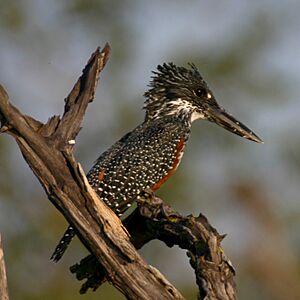Giant kingfisher facts for kids
Quick facts for kids Giant kingfisher |
|
|---|---|
 |
|
| Male, Lake Naivasha, Kenya | |
 |
|
| Female near Triangle, Zimbabwe | |
| Conservation status | |
| Scientific classification | |
| Genus: |
Megaceryle
|
| Species: |
maxima
|
 |
|
| distribution | |
The Giant Kingfisher (its scientific name is Megaceryle maxima) is the biggest kingfisher bird in all of Africa! These amazing birds live in most parts of Africa that are south of the Sahara Desert. They are known as "resident breeding birds," which means they stay in the same area all year round and raise their young there.
Contents
What's in a Name?
Scientists give every animal a special name. The first official description of the Giant Kingfisher was made in 1769. A German scientist named Peter Simon Pallas gave it the name Alcedo maxima. Later, in 1848, another German scientist, Johann Jakob Kaup, placed it in the group (or genus) called Megaceryle.
There are two main types, or subspecies, of Giant Kingfishers:
- M. m. maxima: This type lives in open woodlands called savannas. You can find them from Senegal and Gambia all the way to Ethiopia and south to South Africa.
- M. m. gigantea: This type prefers thick, wet places like tropical rainforests. They live from Liberia to northern Angola and western Tanzania, and also on the island of Bioko.
What Do They Look Like?
Giant Kingfishers are quite large, growing to be about 42 to 46 centimeters (about 16 to 18 inches) long. They have a big, messy-looking crest of feathers on their head. Their large beak is black, and their upper body is black with many fine white spots.
You can tell the difference between male and female Giant Kingfishers:
- The male has a reddish-brown band across its chest. The rest of its belly is white with dark stripes on its sides.
- The female has a black band across her chest, which also has white spots. Her belly is reddish-brown.
The type of Giant Kingfisher that lives in forests (M. m. gigantea) looks a bit darker. It has fewer spots on its back and more stripes on its belly than the savanna type.
When a Giant Kingfisher calls out, it makes a loud sound like wak wak wak.
Reproduction and Life Cycle
Giant Kingfishers are monogamous, meaning they have one partner. They also breed alone, not in groups.
- In South Africa, they lay eggs between September and January.
- In Zimbabwe, it's from August to March.
- In Zambia, they breed in March and April.
- In Liberia, it's from December to January.
Both the male and female work together to build their nest. They dig a long, horizontal tunnel into a river bank using their feet and beaks. The entrance hole is about 11 cm (4.3 inches) high and 15 cm (5.9 inches) wide. The tunnel is usually about 2 meters (6.5 feet) long, but one was found that was an amazing 8.5 meters (28 feet) long! At the very end of the tunnel, they make a special chamber where the female lays about three eggs.
How They Find Food
These big kingfishers are expert hunters! They mostly eat crabs, fish, and frogs. They catch their food by diving headfirst into the water from a perch, like a tree branch or a rock.
Images for kids


